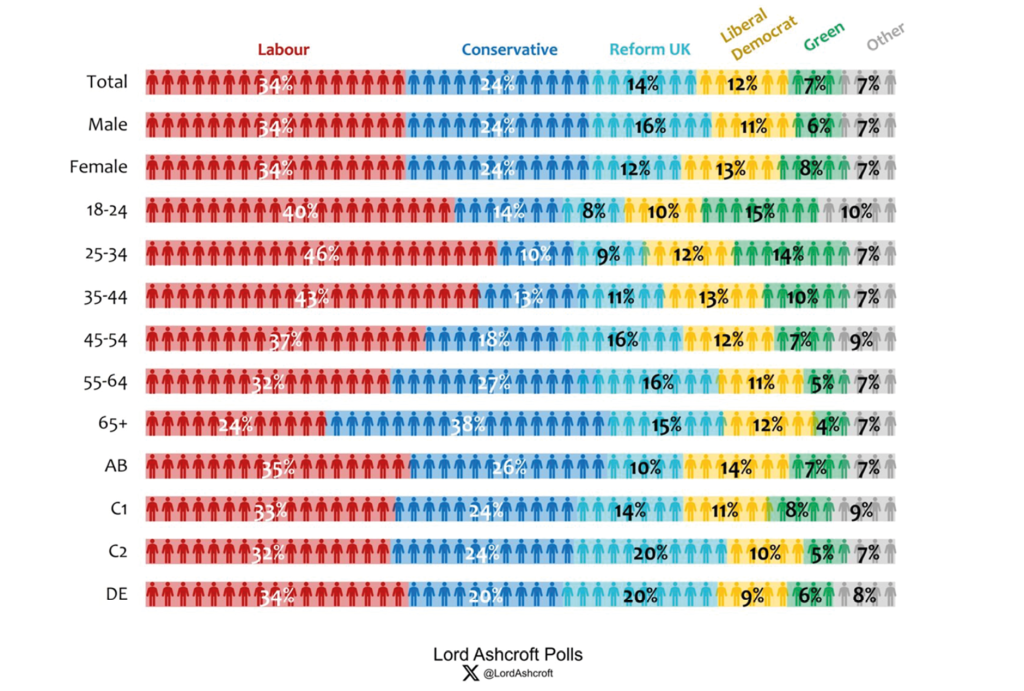
Dr Stephanie Luke
Stephanie is a Research Associate at the University of Sheffield. Her research centres on the behaviour and adaptation of political parties to new political issues and different methods of campaigning.
X: @DrStephanieLuke
Email: s.luke@sheffield.ac.uk

UK Election 2024
Section 2: Voters, polls and results
13. Forecasting a multiparty majoritarian election with a volatile electorate (Dr Hannah Bunting)
14. The emerging infrastructure of public opinion (Dr Nick Anstead)
15. A moving target? Voter segmentation in the 2024 British General Election (Prof Rosie Campbell)
16. Don’t vote, it only encourages them? Turnout in the 2024 Election (Prof Charles Pattie)
17. Cartographic perspectives of the 2024 General Election (Prof Benjamin Hennig)
18. Gender and vote choice: early reflections (Dr Ceri Fowler)
19. Changing Pattern amongst Muslim voters: the Labour Party, Gaza and voter volatility (Dr Parveen Akhtar)
20. Religion and voting behaviour in the 2024 General Election (Dr Ekaterina Kolpinskaya, Dr Stuart Fox)
21. Failure to connect: the Conservative Party and young voters (Dr Stephanie Luke)
22. Youthquake for the progressive left: making sense of the collapse of youth support for the Conservatives (Prof James Sloam, Prof Matt Henn)
23. Values in the valence election (Prof Paula Surridge)
24. Tactical voting: why is it such a big part of British elections? (Thomas Lockwood)
People aged 32 or younger have lived under a Conservative government their entire adult lives. This General Election has shown that there continues to be one group of voters that political parties struggle to engage with – young voters. While we should acknowledge the issues with treating young voters, typically under 35s, as a homogenous group, they are less likely to vote Conservative than older voters and less likely to vote in general. Data from the Lord Ashcroft Poll of those who had already voted offers a clear indication of the generational divide. As Figure 1 shows 14% of 18-24 and 10% of 25–34-year-olds voted for the Conservative Party, contrast that with 27% of 55-64 year olds and 38% of people aged 65 and over.
This trend began to appear prior to this election. Sloam, Eshan and Henn have shown that in response to the dramatic surge of Labour support among younger voters in the 2017 general election, the Conservative Party needed to “try harder to develop a package of policies that can appeal to young people”. In this election, the Conservative Party have tried to appeal to young voters, from 100,000 more apprenticeships a year to scrapping ‘rip-off degrees’, as part of a larger push to improve education and employment opportunities for young people. The Conservative Party also joined TikTok – a platform used particularly by those aged 18-34 – but in their first post they announced that 18-year olds would be required to take part in national service. The Party insisted that this policy was designed to appeal to young voters, but the polls suggested actually it was more popular with their core voters – older age groups.
The Conservative Party have notably struggled to engage young voters, but in the lead up to this election, the polls had continuously predicted that the Conservatives would be behind Labour, in some cases by over 20 points. This election was therefore not about the Conservative Party seeking to gain seats, but about protecting the ones they currently hold. Nearly 9 in 10 (88%) of Sunak’s 51 Constituency visits were to seats his party was defending. Therefore, it was evident from the beginning of this campaign that the Conservative Party had a ‘core voter strategy’, which meant that their main focus was on ensuring that their core supporters – older people – went out and voted for them. This focus on older voters is a strategy aimed at damage limitation. This largely meant that young voters were not targeted to any great extent.
Although the issues that matter to young voters are not wholly different to the older voters that the Conservative Party were targeting. Ipsos polling indicated that both younger and older voters believed that the most important issues facing Britain included both the NHS and the economy. While the Conservative Party addressed these issues, they did so by announcing policies for older people such as pledging to increase the income pensioners can receive before they are taxed.
The core voter strategy was intended to reverse their dire poll ratings, but this strategy focused on older voters, the people that are already most likely to vote for him. While the ‘core voter’ strategy was intended to shore up past voter support, it did not help them to avoid an historic defeat, left with only 121 seats. This left many Conservatives, many of whom had lost their seats, pondering on what changes needed to be made.
The ‘core voter’ strategy has come under scrutiny with former Conservative MP Miriam Cates suggesting that if the Conservative Party is to have a future, “it must become a party for all ages”. Former Conservative minister Damian Green also reiterated that the Conservative Party needs to start listening to the priorities of young people, suggesting that in recent years the party had shied away from decisions which would help young people in case it would annoy older voters.
However, this acknowledgement that the Conservative Party needs to engage young voters is something that they have recognised previously within their own ranks. Sir Robert Buckland (now former MP for Swindon South) warned in 2023 that “if the Conservative Party is not alive to the demographic time bomb that is about to blow up in our face we will be out of Government for a generation”.
While the Conservative Party may be reflecting on their historically bad result, appealing to young voters is a solution that has been suggested before. However, while older people may make up a high proportion of the electorate and are more likely to vote, the Conservative Party cannot rely on older voters to vote for them. Therefore, reiterating Sloam, Eshan and Hann, the Conservative Party needs to produce policies that can appeal to young people. Broadening out their appeal could help to prevent such a dire collapse in electoral support.

